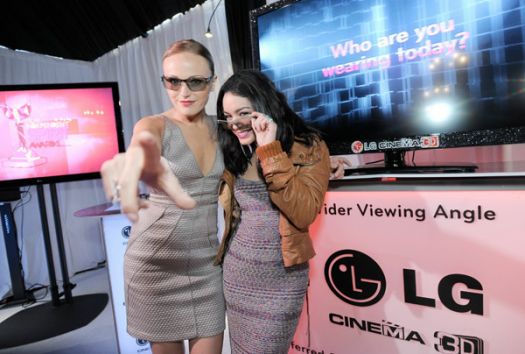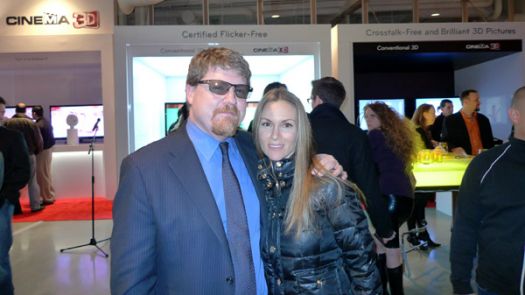Last month, LG sponsored the Independent Spirit Awards in Los Angeles and unveiled their new cinema 3D TV models at an exclusive after party packed with stars. Ok maybe packed isn't the right word, but there were certainly some A-list celebs on hand to help ring in the new TV line including Hilary Swank (taller than I expected) and Gerard Butler (ditto). We're reasonably sure that the Cinema 3D TVs that the stars took home in their gift bags had nothing to do with their appearance at the party.
The real stars of the evening were the new LED TVs in LG's Cinema 3D TV line. Cinema 3D is LG's name for their passive 3D solution. These sets use a technique called circular polarization to create a realistic 3D image that can be decoded with inexpensive lightweight passive 3D glasses, just like the ones you see in movie theaters, as opposed to the expensive active 3D eyewear favored by competitors such as Panasonic, Samsung and Sony.
There are advantages to both approaches. Active solutions present a higher resolution 3D image (typically full HD 1080p to both eyes) while passive 3D TVs split that 1080p resolution in half to each eye. But passive 3D solutions tend to have less overall light loss in transmission which means a brighter image that can hold up to some ambient room lighting. Also passive 3D glasses are not only much less expensive than active 3D glasses, but they're also lighter and more comfortable for extended viewing sessions. Though passive 3D viewing does feature a more restricted vertical viewing angle, you can still get an excellent and believable illusion of depth from a passive 3D system as long as you are viewing the set from a suitable distance and within that vertical sweet spot.

The LG Cinema 3D models on hand at the party did look good in both 2D and 3D modes, with 2D mode offering full HD 1080p resolution and nicely saturated colors and 3D mode offering a deep view into the content. I did notice that some of the cheap 3D glasses they were handing out at the party introduced more crosstalk (ghosting of left and right eye images) than others, so we'll have to keep this in mind when reviewing the new sets and will try not to blame any artifacts on badly polarized cheap plastic lenses.
One way to solve the low quality optics issue is to invest in high quality eyewear. If you need prescription glasses, many opticians can now provide prescription eyewear that is polarized for use with passive 3D TV systems such as these LG models. For those who don't need a prescription, companies such as Gunnar Optiks will provide stylish, high quality 3D glasses that are designed to provide the highest quality 3D image with minimal eyestrain. Gunnar Optiks co-founder Jenny Michelson was at the LG/ISA party showing off her custom 3D specs. I tried them out and definitely noticed the difference, with colors appearing more vivid and crosstalk pretty much non-existent. Gunnar Optiks custom 3D glasses start at approximately $99/pair. You can find out more at gunnars.com.

But back to the issue of passive 3D TV, we wanted to see what LG's feelings were in the active vs. passive 3D TV debate, since the company produces both types of television. In a conversation with LG's Director of New Product Development, Tim Alessi, we learned that while the company plans to offer both active and passive 3D TV models in 2011, they expect to offer the passive Cinema 3D models exclusively in 2012 and beyond. According to their own market research and focus groups, consumers preferred the passive 3D TV experience three-to-one, even when told that it offered lower detail than the active solution. As far as we're concerned the jury is still out on that, but we look forward to getting these new sets into the BPBS labs for our own evaluation.
Related Article:
Where to Buy: